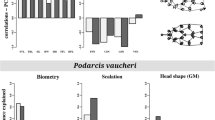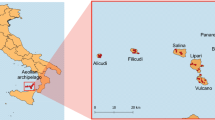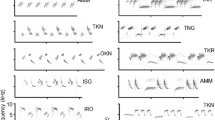Abstract
Geographical and environmental distances influence the divergence of characters among biological populations, especially on a macro spatial scale, making it difficult to interpret the individual contribution of these predictor variables in the process of population differentiation. Anurans are excellent models for multi-character evolutionary studies, due to their low vagility and frequent territoriality, causing certain environmental changes to result in barriers that isolate populations. Accordingly, we propose to test the correlation of environmental and geographical distances in the absence of obvious vicariant barriers with phenotypic and genotypic population characters using, as a study model, an Amazonian litter-frog (Allobates sumtuosus). Combining univariate and multivariate analyses, and Structural Equation Modeling, we tested the general hypotheses that geographical and environmental distances affect the variation in the morphometric, acoustic and genetic characters of this frog along a latitudinal gradient at a fine spatial scale. We found that the latitudinal variation was the most correlated with the variation of the studied characters, with an explanatory force always greater than 78%. Therefore, we suggest that there is a combined effect of latitude and environment on phenotypic characteristics in A. sumtuosus. These factors shape the acoustic characters of this species through pressures on body size, as confirmed by a regression analysis showing that larger body sizes resulted in lower-spectral frequency acoustic signals. This is because the climatic environmental gradient occupied by the species promotes changes in the area-volume relationship of individuals, resulting in larger body sizes towards the Equator. Although we observed a pronounced intrapopulation genetic structure, it was not associated with phenotypic variation. In summary, our study breaks down the stages of speciation for this Amazonian litter-frog, demonstrating that environmental factors lead to changes in the sexual signal due to the variation in body size.





Similar content being viewed by others
References
Aljanabi, S. M., & Martinez, I. (1997). Universal and rapid salt-extraction of high quality genomic DNA for PCR-based techniques. Nucleic Acids Research, 25(22), 4692–4693.
Amézquita, A., Flechas, S. V., Lima, A. P., et al. (2011). Acoustic interference and recognition space within a complex assemblage of dendrobatid frogs. Proceedings of the National Academy of Sciences, 108(41), 17058–17063.
Amézquita, A., Lima, A. P., Jehle, R., et al. (2009). Calls, colours, shape, and genes: A multi-trait approach to the study of geographic variation in the Amazonian frog Allobates femoralis. Biological Journal of the Linnean Society, 98(4), 826–838.
Barrett, J. C., Fry, B., Maller, J. D., et al. (2005). Haploview: Analysis and visualization of LD and haplotype maps. Bioinformatics, 21(2), 263–265.
Beebee, T. J. C. (2005). Conservation genetics of amphibians. Heredity, 95(6), 423–427.
Bevier, C. R., Gomes, F. R., & Navas, C. A. (2008). Variation in call structure and calling behavior in treefrogs of the genus Scinax. South American Journal of Herpetology, 3(3), 196–206.
Boul, K. E., Chris Funk, W., Darst, C. R., et al. (2007). Sexual selection drives speciation in an Amazonian frog. Proceedings of the Royal Society B: Biological Sciences, 274(1608), 399–406.
Charif, R. A., Waack, A. M., & Strickman, L. M. (2010). Raven pro 1.4 user’s manual (p. 25506974). Ithaca, NY: Cornell Lab of Ornithology.
Chu, C., Lutz, J. A., Král, K., et al. (2019). Os efeitos diretos e indiretos do clima sobre a riqueza impulsionam o gradiente de diversidade latitudinal nas árvores da floresta. Ecology Letters, 22(2), 245–255.
Corander, J., & Marttinen, P. (2006). Bayesian identification of admixture events using multilocus molecular markers. Molecular Ecology, 15(10), 2833–2843.
Corander, J., Marttinen, P., Sirén, J., & Tang, J. (2008). Enhanced Bayesian modelling in BAPS software for learning genetic structures of populations. BMC Bioinformatics, 9(1), 539.
Cortázar-Chinarro, M., Lattenkamp, E. Z., Meyer-Lucht, Y., et al. (2017). Drift, selection, or migration? Processes affecting genetic differentiation and variation along a latitudinal gradient in an amphibian. BMC Evolutionary Biology, 17(1), 189.
Dal Vechio, F., Prates, I., Grazziotin, F. G., et al. (2018). Phylogeography and historical demography of the arboreal pit viper Bothrops bilineatus (Serpentes, Crotalinae) reveal multiple connections between Amazonian and Atlantic rain forests. Journal of Biogeography, 45(10), 2415–2426.
de Luna, A. G., Hödl, W., & Amezquita, A. (2010). Colour, size and movement as visual subcomponents in multimodal communication by the frog Allobates femoralis. Animal Behaviour, 79(3), 739–745.
De Queiroz, K. (2007). Species concepts and species delimitation. Systematic Biology, 56(6), 879–886.
Duarte, M. D. O., Freitas, T. M. D. S., & Prudente, A. L. D. C. (2015). Polychromatism of populations of Corallus hortulanus (Squamata: Boidae) from the southern Amazon Basin Brazil. Acta Amazonica, 45(4), 373–382.
Ernst, R., & Rödel, M. O. (2008). Patterns of community composition in two tropical tree frog assemblages: Separating spatial structure and environmental effects in disturbed and undisturbed forests. Journal of Tropical Ecology, 24(2), 111–120.
Erdtmann, L., & Amézquita, A. (2009). Differential evolution of advertisement call traits in dart-poison frogs (Anura: Dendrobatidae). Ethology, 115(9), 801–811.
Erdtmann, L., & Lima, A. P. (2013). Environmental effects on anuran call design: What we know and what we need to know. Ethology Ecology & Evolution, 25(1), 1–11.
Ferreira, A. S., Jehle, R., Stow, A. J., & Lima, A. P. (2018). Soil and forest structure predicts large-scale patterns of occurrence and local abundance of a widespread Amazonian frog. Peer J, 6, e5424.
Ferreira, A. S., Lima, A. P., Jehle, R., Ferrão, M., & Stow, A. (2020). The influence of environmental variation on the genetic structure of a poison frog distributed across continuous Amazonian rainforest. Journal of Heredity, 111(5), 457–470.
Ficetola, G. F., & Maiorano, L. (2016). Contrasting effects of temperature and precipitation change on amphibian phenology, abundance and performance. Oecologia, 181(3), 683–693.
Fouquet, A., Gilles, A., Vences, M., et al. (2007). Underestimation of species richness in neotropical frogs revealed by mtDNA analyses. PLoS ONE, 2, 1–10.
Gingras, B., Boeckle, M., Herbst, C. T., & Fitch, W. T. (2013). Call acoustics reflect body size across four clades of anurans. Journal of Zoology, 289(2), 143–150.
Hengl, T., de Jesus, J. M., MacMillan, R. A., et al. (2014). soilGrids1km—Global soil information based on automated mapping. PLoS ONE, 9(8), e105992.
Hijmans, R. J., Cameron, S. E., Parra, J. L., et al. (2005). Very high resolution interpolated climate surfaces for global land areas. International Journal of Climatology, 25(15), 1965–1978.
Hijmans, R. J., Van Etten, J., Cheng, J., et al. (2015). Package ‘raster’. R package, 734.
Hoskin, C. J., James, S., & Grigg, G. C. (2009). Ecology and taxonomy-driven deviations in the frog call–body size relationship across the diverse Australian frog fauna. Journal of Zoology, 278(1), 36–41.
Hurvich, C. M., & Tsai, C. L. (1991). Bias of the corrected AIC criterion for underfitted regression and time series models. Biometrika, 78(3), 499–509.
Jaramillo, C., Rand, A. S., Ibáñez, R., & Dudley, R. (1997). Elastic structures in the vocalization apparatus of the tungara frog Physalaemus pustulosus (Leptodactylidae). Journal of morphology, 233(3), 287–295.
Jombart, T. (2008). adegenet: A R package for the multivariate analysis of genetic markers. Bioinformatics, 24(11), 1403–1405.
Jorge, R. F., Simões, P. I., Magnusson, W. E., & Lima, A. P. (2016). Fine-scale habitat heterogeneity explains the local distribution of two Amazonian frog species of concern for conservation. Biotropica, 48(5), 694–703.
Juncá, F. A. (1998). Reproductive biology of Colostethus stepheni and Colostethus marchesianus (Dendrobatidae), with the description of a new anuran mating behavior. Herpetologica, 54, 377–387.
Juo, A. S. R., & Franzluebbers, K. (2003). Tropical soils: Properties and management for sustainable agriculture. New York, NY: Oxford University Press.
Kaefer, I. L., & Lima, A. P. (2012). Sexual signals of the Amazonian frog Allobates paleovarzensis: Geographic variation and stereotypy of acoustic traits. Behavior, 149(1), 15–33.
Kaefer, I. L., Tsuji-Nishikido, B. M., Mota, E. P., et al. (2013). The early stages of speciation in Amazonian forest frogs: Phenotypic conservatism despite strong genetic structure. Evolutionary Biology, 40(2), 228–245.
Katoh, K., Rozewicki, J., & Yamada, K. D. (2019). MAFFT online service: Multiple sequence alignment, interactive sequence choice and visualization. Briefings in Bioinformatics, 20(4), 1160–1166.
Katoh, K., & Standley, D. M. (2013). MAFFT multiple sequence alignment software version 7: Improvements in performance and usability. Molecular Biology and Evolution, 30(4), 772–780.
Kearse, M., Moir, R., Wilson, A., et al. (2012). Geneious basic: An integrated and extendable desktop software platform for the organization and analysis of sequence data. Bioinformatics, 28(12), 1647–1649.
Keller, A., Rödel, M. O., Linsenmair, K. E., et al. (2009). The importance of environmental heterogeneity for species diversity and assemblage structure in Bornean stream frogs. Journal of Animal Ecology, 78(2), 305–314.
Kobayashi, S., Abe, S., Tomita, M., et al. (2018). Fine-scale genetic structure and estimation of gene flow of the Japanese brown frog Rana japonica in a Satoyama landscape on the western side of Inba Lake Eastern Japan. Current Herpetology, 37(1), 11–22.
Lampert, K. P., Rand, A. S., Mueller, U. G., et al. (2003). Fine-scale genetic pattern and evidence for sex-biased dispersal in the túngara frog Physalaemus pustulosus. Molecular Ecology, 12(12), 3325–3334.
Lanfear, R., Frandsen, P. B., Wright, A. M., et al. (2017). PartitionFinder 2: New methods for selecting partitioned models of evolution for molecular and morphological phylogenetic analyses. Molecular Biology and Evolution, 34(3), 772–773.
Leão-Pires, T. A., Luiz, A. M., & Sawaya, R. J. (2018). The complex roles of space and environment in structuring functional, taxonomic and phylogenetic beta diversity of frogs in the Atlantic Forest. PLoS ONE, 13(4), e0196066.
Liao, W., & Lu, X. (2012). Adult body size= f (initial size+ growth rate× age): Explaining the proximate cause of Bergman’s cline in a toad along altitudinal gradients. Evolutionary Ecology, 26(3), 579–590.
Liberato, A. M., & Brito, J. I. B. (2010). Influência de mudanças climáticas no balanço hídrico da Amazônia Ocidental. Revista Brasileira de Geografia Física, 3(3), 170–180.
Liu, Q., Feng, H., Jin, L., et al. (2018). Latitudinal variation in body size in Fejervarya limnocharis supports the inverse of Bergmann’s rule. Animal Biology, 68(2), 113–128.
Maia, G. F., Lima, A. P., & Kaefer, I. L. (2017). Not just the river: Genes, shapes, and sounds reveal population-structured diversification in the Amazonian frog Allobates tapajos (Dendrobatoidea). Biological Journal of the Linnean Society, 121(1), 95–108.
Maia-Carvalho, B., Vale, C. G., Sequeira, F., et al. (2018). The roles of allopatric fragmentation and niche divergence in intraspecific lineage diversification in the common midwife toad (Alytes obstetricans). Journal of biogeography, 45(9), 2146–2158.
Marchesini, A., Ficetola, G. F., Cornetti, L., et al. (2017). Fine-scale phylogeography of Rana temporaria (Anura: Ranidae) in a putative secondary contact zone in the southern Alps. Biological Journal of the Linnean Society, 122(4), 824–837.
Martin WF (1972) Evolution of vocalization in the genus Bufo. Evolution in the genus Bufo, pp 279–309
Menin, M., Lima, A. P., Magnusson, W. E., et al. (2007). Topographic and edaphic effects on the distribution of terrestrially reproducing anurans in Central Amazonia: Mesoscale spatial patterns. Journal of Tropical Ecology, 23(5), 539–547.
Mitchell, A., & Bergmann, P. J. (2016). Thermal and moisture habitat preferences do not maximize jumping performance in frogs. Functional Ecology, 30(5), 733–742.
Montanarin, A., Kaefer, I. L., & Lima, A. P. (2011). Courtship and mating behaviour of the brilliant-thighed frog Allobates femoralis from Central Amazonia: Implications for the study of a species complex. Ethology Ecology & Evolution, 23(2), 141–150.
Moraes, L. J. C. L., Pavan, D., Barros, M. C., & Ribas, C. C. (2016). The combined influence of riverine barriers and flooding gradients on biogeographical patterns for amphibians and squamates in south-eastern Amazonia. Journal of Biogeography, 43(11), 2113–2124.
Morales, V. (2002). Sistemática y biogeografía del grupo trilineatus (Amphibia, Anura, Dendrobatidae, Colostethus). Publicaciones de La Asociacíon de Amigos de Doñana, 13, 1–59.
Morales-Jimenez, A. L., Disotell, T., & Di Fiore, A. (2015). Revisiting the phylogenetic relationships, biogeography, and taxonomy of spider monkeys (genus Ateles) in light of new molecular data. Molecular Phylogenetics and Evolution, 82, 467–483.
Morton, E. S. (1975). Ecological sources of selection on avian sounds. The American Naturalist, 109(965), 17–34.
Mullen, L. M., Vignieri, S. N., Gore, J. A., et al. (2009). Adaptive basis of geographic variation: Genetic, phenotypic and environmental differences among beach mouse populations. Proceedings of the Royal Society B: Biological Sciences, 276(1674), 3809–3818.
Naka, L. N., & Brumfield, R. T. (2018). The dual role of Amazonian rivers in the generation and maintenance of avian diversity. Science Advances, 4(8), eaar8575.
Newman, R. A., & Squire, T. (2001). Microsatellite variation and fine-scale population structure in the wood frog (Rana sylvatica). Molecular Ecology, 10(5), 1087–1100.
Ng, J., Landeen, E. L., Logsdon, R. M., & Glor, R. E. (2013). Correlation between Anolis lizard dewlap phenotype and environmental variation indicates adaptive divergence of a signal important to sexual selection and species recognition. Evolution International Journal of Organic Evolution, 67(2), 573–582.
Ortiz, D. A., Lima, A. P., & Werneck, F. P. (2018). Environmental transition zone and rivers shape intraspecific population structure and genetic diversity of an Amazonian rain forest tree frog. Evolutionary Ecology, 32(4), 359–378.
Palumbi, S. R. (1996). Nucleic acids II: The polymerase chain reaction. In D. M. Hillis, C. Moritz, & B. K. Mable (Eds.), Molecular Systematics (pp. 205–247). Sunderland, MA: Sinauer & Associates Inc.
R Core Team (2019) R: A language and environment for statistical com- puting. R Foundation for Statistical Computing
Raffel, T. R., Rohr, J. R., Kiesecker, J. M., & Hudson, P. J. (2006). Negative effects of changing temperature on amphibian immunity under field conditions. Functional Ecology, 20(5), 819–828.
Rambaut, A., Drummond, A. J., Xie, D., et al. (2018). Posterior summarization in Bayesian phylogenetics using Tracer 1.7. Systematic Biology, 67(5), 901–904.
Ribas, C. C., Aleixo, A., Gubili, C., et al. (2018). Biogeography and diversification of Rhegmatorhina (Aves: Thamnophilidae): Implications for the evolution of Amazonian landscapes during the Quaternary. Journal of Biogeography, 45(4), 917–928.
Ribeiro, J. E. L. S., Hopkins, M. G., Vicentini, A., et al. (1999). Flora da Reserva Ducke: Guia de Identificação das Plantas Vasculares de uma Floresta de Terra Firme na Amazônia Central. Manaus: INPA.
Ronquist, F., Teslenko, M., Van Der Mark, P., et al. (2012). MrBayes 3.2: Efficient Bayesian phylogenetic inference and model choice across a large model space. Systematic Biology, 61(3), 539–542.
Rojas, D., Lima, A. P., Momigliano, P., et al. (2019). The evolution of polymorphism in the warning coloration of the Amazonian poison frog Adelphobates galactonotus. Heredity, 124(19), 1–18.
Rosseel, Y. (2012). Lavaan: An R package for structural equation modeling and more. Version 0.5–12 (BETA). Journal of Statistical Software, 48(2), 1–36.
Simões, P. I., Kaefer, I. L., Farias, I. P., & Lima, A. P. (2013). An integrative appraisal of the diagnosis and distribution of Allobates sumtuosus (Morales, 2002) (Anura, Aromobatidae). Zootaxa, 3746(3), 401–421.
Simões, P. I., & Lima, A. P. (2012). The tadpole of Allobates sumtuosus (Morales, ‘2000’2002) (Anura: Aromobatidae) from its type locality at Reserva Biológica do Rio Trombetas, Pará Brazil. Zootaxa, 3499(1), 86–88.
Simões, P. I., Stow, A., Hödl, W., et al. (2014). The value of including intraspecific measures of biodiversity in environmental impact surveys is highlighted by the Amazonian brilliant-thighed frog (Allobates femoralis). Tropical Conservation Science, 7(4), 811–828.
Spurgin, L. G., Illera, J. C., Jorgensen, T. H., et al. (2014). Genetic and phenotypic divergence in an island bird: Isolation by distance, by colonization or by adaptation? Molecular Ecology, 23(5), 1028–1039.
Stamatakis, A. (2014). RAxML version 8: A tool for phylogenetic analysis and post-analysis of large phylogenies. Bioinformatics, 30(9), 1312–1313.
Tryjanowski, P., Sparks, T., Rybacki, M., et al. (2006). Is body size of the water frog Rana esculenta complex responding to climate change? Naturwissenschaften, 93(3), 110–113.
Valenzuela-Sánchez, A., Cunningham, A. A., & Soto-Azat, C. (2015). Geographic body size variation in ectotherms: Effects of seasonality on an anuran from the southern temperate forest. Frontiers in Zoology, 12(1), 37.
van Rensburg AJ, Cortazar-Chinarro M, Laurila A et al (2018). Adaptive genomic variation associated with environmental gradients along a latitudinal cline in Rana temporaria. biorxiv 427872
Vences, M., Thomas, M., Van der Meijden, A., et al. (2005). Comparative performance of the 16S rRNA gene in DNA barcoding of amphibians. Frontiers in Zoology, 2(1), 5.
Zeisset, I., & Beebee, T. J. C. (2008). Amphibian phylogeography: A model for understanding historical aspects of species distributions. Heredity, 101(2), 109–119.
Zimmerman, B. L., & Bierregaard, R. (1986). Relevance of the equilibrium theory of island biogeography and species-area relations to conservation with a case from Amazonia. Journal of Biogeography, 13(2), 133–143.
Acknowledgements
We are grateful to the National Council for Scientific and Technological Development (CNPq) for the financial support through productivity grants to MM, IPF, APL and ILK; and a research grant (Universal 405640/2016-1) for MM. The Amazon Research Support Foundation (FAPEAM) for the master's scholarship to IYF. The Coordination for the Improvement of Higher Education Personnel (CAPES) for financial support and the Graduate Program in Ecology (PPG-Eco INPA) for structural and logistical support. Specimens were collected under collection permit 67501-2 provided by the Chico Mendes Institute for Biodiversity Conservation (ICMBio).
Author information
Authors and Affiliations
Corresponding author
Ethics declarations
Conflict of interest
The author declares that he has no conflict of interest.
Supplementary Information
Below is the link to the electronic supplementary material.
Rights and permissions
About this article
Cite this article
Fernandes, I.Y., Moraes, L.J.C.L., Menin, M. et al. Unlinking the Speciation Steps: Geographical Factors Drive Changes in Sexual Signals of an Amazonian Nurse-Frog Through Body Size Variation. Evol Biol 48, 81–93 (2021). https://doi.org/10.1007/s11692-020-09525-7
Received:
Accepted:
Published:
Issue Date:
DOI: https://doi.org/10.1007/s11692-020-09525-7




